|
|
 |
Fiche d'espèce de Copépode |
|
|
Calanoida ( Ordre ) |
|
|
|
Clausocalanoidea ( Superfamille ) |
|
|
|
Aetideidae ( Famille ) |
|
|
|
Euchirella ( Genre ) |
|
|
| |
Euchirella bella Giesbrecht, 1888 (F,M) | |
| | | | | | | Syn.: | Euchirella hessei : A. Scott, 1909 (p.54, Rem.);
E. rostrata : Thompson & Scott, 1903 p.244);
E. areata Tanaka, 1957 b (p.186, figs.F); Chen & Zhang, 1965 (p.52, figs.F); Shih & Young, 1995 (p.67); Padmavati & al., 1998 (p.347);
E. bella var. indica : Wolfenden, 1905 (1906) (p.1006, figs.F); Noda & al., 1998 (p.55, Table 3, occurrence);
no E. bella : C.B. Wilson, 1950 (p.218, figs.F); Fagetti, 1962 (p.19) | | | | Ref.: | | | Giesbrecht, 1892 (p.233, 244, Descr.F, figs.F); Giesbrecht & Schmeil, 1898 (p.35); Sewell, 1929 (p.107, 109: Rem.); 1947 (p.71, figs.F, Rem., [non M]); Vervoort, 1949 (p.17, figs.M); Grice, 1962 (p.194, figs.F,M, Rem.); Vervoort, 1963 b (p.134: Rem.); Vidal, 1968 (p.28, figs.F); Tanaka & Omori, 1969 (p.38, figs.F,M); Vaupel Klein, 1972 (p.501, 504, figs.F,M); 1984 a (p.36, figs.F, Table II: characters, Rem.); He & al., 1992 (p.250); Markhaseva, 1996 (p.147, figs.F,M); Chihara & Murano, 1997 (p.685, Pl.36,41: F,M); Mulyadi, 2001 (p.810, figs.F,M, Rem.); Mulyadi, 2004 (p.41, figs.F,M, Rem.); |  issued from : Mulyadi in Crustaceana, 2001, 74 (9). [Fig.1, p.812]. Female (from Flores Sea): a, habitus (dorsal view); b, Cephalon (lateral view); ; c, A2; d, P4; e, basis of P4. Male: f, habitus (dorsal view); g, Cephalon (lateral view); h, P5; i, distal segment of left P5.
|
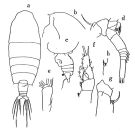 issued from : Tanaka O. in Publ. Seto Mar. Biol. Lab., 1957, 6 (2). [Fig.50, p.186]. As Euchirella areata. Female (from Sagami): a, habitus (dorsal aspect); b, head (lateral aspect); c, last thoracic segment and urosome (lateral aspect); d, A2; e, endopodite and second basal joint of Mx1; f, P1; g, basal joints of P4; h, inner margin of first basal joint of P4. Nota Female: - Cephalothorax about 4.44 times the abdomen length (3.06 : 0,69). - Head and 1st pediger segment separate,4th and 5th thoracic segments fused. - Posterolateral corners of last thoracic segment rounded. - Rostrum small; frontal organ prominent. - Abdomen 4-segmented; segments and caudal rami in the proportional lengths 51 : 13 : 10 : 8 : 18 = 100. - Genital segment asymmetrical; the right side more inflated on the lateral margin; dorsal surface concave at the proximal half, and there is a slight protuberance on the periphery of the hollow on the right side. - A1 24-segmented; exceeds distal end of caudal rami by distal 2 segments. - A2 with a very short endopod about 1/5 the length of exopod; distal segment of endopod with 10 setae. - Md with exopod a little longer than endopod (10 : 8). Mx1 endopod with 4 setae; 2nd basal segment with 2 setae, of which the proximal one is very short. - Mx2 and Mxp as those of E. rostrata. - P1 exopod 2-segmented; 1st exopodal segment with 2 outer edge spines. - P2 and P3 as those of E. rostrata. - P4 coxa with on the inner face spines of which the outer one is notched at the apex; the spine of the left leg was broken off, but the indication of bifurcation is slightly oberved.
|
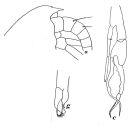 Issued from : W. Vervoort in Zool. Verh., Leiden, 1949, 5. [p.18, Fig.8,a; 19, Fig.9,c,g]. Male (from Sawoe Sea): a, forehead (lateral right side); c, P5; g, terminal part of the left P5. Nota: Head and 1st thoracic segment fused, 4th and 5th fused. The appearence of the claw on the left P5 depends on the angle from which this appendage is seen and on the position of the short, 3rd exopodal segment.
|
 issued from: Q.-c Chen & S.-z. Zhang in Studia Marina Sinica, 1965, 7. [Pl.13, 18-23]. As Euchirella areata. Female (from E China Sea): 18, habitus (dorsal); 19, forehead (lateral); 20, left A2; 21, P1 (anterior); 22, basipod of P4 (posterior); 23, urosome (lateral right side).
|
 issued from : R.B.S. Sewell in The John Murray Expedition, 1933-34, Scientific Reports, VIII (1), 1947. [p.72, Fig.13, A]. Female (from Arabian Sea): A, Mx1. Nota: Proportional lengths of cephalothorax and abdomen as 78 to 22. The proportional lengths of the various segments of the body (cephalon to caudal rami) as 389:146:88:79:88:92:36:29:13:40 = 1000. Head and 1st pediger segment fused, but the line of fusion is visible across the dorsal aspect. The posterior margins of the genital segment and 3rd urosomal segments are fringed on the dorsal view with a series of weak spines, that appear to have produced by the splitting of the chitinous margin. Anal segment very short, telescoped into the 4 th, and bears a tuft of hairs on the ventral aspect. A1 23-segmented (8- 9, 24-25 respectively fused), reaches back to about the middle of the abdomen.
|
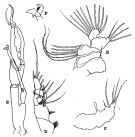 issued from : R.B.S. Sewell in The John Murray Expedition, 1933-34, Scientific Reports, VIII (1), 1947. [p.72, Fig.13, B-F]. A doubt subsists concernig the attibution of this male to E. bella, but Sewell has no doubt for his attibution because the association with the females (criterion not absolutely sure). Male (from Arabian Sea) B, Mx1; C, Mx2; D, P1; E, P5; F, terminal claw of left P5. Nota: Proportional lengths of the cephalothorax and urosome as 73 to 27. The proportional lengths of the various segments of the body (cephalon to caudal rami) as 462:90:80:104:75:52:47:47:14:28 = 1000. Head and 1sst pediger segment fused, 4th and 5th fused. Forehead rounded, without crest, and rostrum depressed. Urosome 5-segmented, the anal segment almost completely telescoped into the 4th.; 2nd, 3rd and 4th urosomal segments provided along their posterior margins with a row of triangular spines. The anal segment bears a tuft of hairs ventrally. A1 reaches back to about the middle of the urosome; certain segments are fused together, but this fusion differs on the two sides; on the left side, segments 8 and 9 fused and segment 10 partially with 9, segments 12 , 13 and 24, 25 are fused respectively; on the right side, in addition, segments 20 and 21 fused. In A2 the endopod is about half the length of the exopod. Md reduced and the biting blade absent. Mx1 reduced (similar to that of E. messinensis as figured by Giesbrecht (1902, Pl.XV, fig.17); the inner lobes entirely absent, and the 2nd basal segment and small endopod are fused, the latter is rounded distally and bears 3 setae; the exopod is well formed and bears 10 setae, and the outer lobe bears 6 setae. Mx2 reduced to a small, only partially segmented, process. In P1 the exopod is 2-segmented, of which the proximal is devoid of any marginal spines, 2 glands appear to open on the external margin, one near the middle of the segment and the second at the distal outer angle; the endopod 1-segmented, and the outer margin is produced in a rounded swelling that bears a row of needle-like spinules. P2, P3 and P4 resemble those of the female. P5 closely resemble those of E. messinensis Giesbrecht, E. pulchra (Lubbock), E. propria Esterly, E. orientalis Sewell and E. media With.
|
 issued from : J.C. von Vaupel Klein in Crustaceana, Supplt 9, Studies on Copepoda, III, 1984. [p.74, Fig.12, c]. Female: c, setal armature of exopod of Mx1 (left one in posterior aspect; all setae are plumose). Nota: 10 setae-condition (see E. formosa p.74, fig.12 a).
|
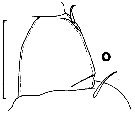 issued from : J.C. von Vaupel Klein in Crustaceana, Supplt 9, Studies on Copepoda, III, 1984. [p.63, Fig.5, o]. Female: o, setal armature of endopodite 1 of A2 (note: one short seta only). Scale bar 0.1 mm.
|
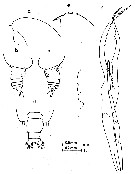 issued from : O. Tanaka & M. Omori in Publ. Seto mar. Biol. Lab., 1969, XVII, 1. [p.39, Fig.2, a-f, l]. Female (from Pacific): a, forehead (lateral); b-d, last thoracic segment and urosome (right lateral, left lateral and dorsal, respectively); Male: e, forehead (lateral); f, P5; l, right P5 (inner margin of exopod of another specimen).
|
 issued from : O. Tanaka & M. Omori in Publ. Seto mar. Biol. Lab., 1969, XVII, 1. [p.39, Fig.2, g-k]. Male: g-k, left P5 (distal segment of exopod of different specimens)
|
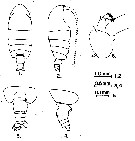 issued from : G.D. Grice in Fish. Bull. Fish and Wildl. Ser., 1962, 61. [p.193, Pl.9, Figs.1-5]. Female (from equatorial Pacific): 1-2, habitus (dorsal and lateral, respectively); 3, posterior part of thorax and urosome (dorsal); 4, same (lateral, right side); 5, basipod and endopod of A2. Nota: Genital segment nearly symmetrical in dorsal view, and produced in ventral view. 2nd endopodal segment of A2 with 5 setae on the outer and 5 setae on the inner lobe (Giesbrecht & Schmeil, 1898, state that there are 6 and 5 setae on these respective lobes.
|
 issued from : G.D. Grice in Fish. Bull. Fish and Wildl. Ser., 1962, 61. [p.193, Pl.9, Figs.6-9]. Female: 6-9, P1 to P4, rspectively. Nota: The number of spines on the 1st basipodal segment of P4 is variable; some specimens have 5 on each side and others have 4 on one side and 3 on the other.
|
 issued from : G.D. Grice in Fish. Bull. Fish and Wildl. Ser., 1962, 61. [p.193, Pl.9, Figs.10-13]. Male: 10-11, habitus (dorsal and lateral, respectively); 12, P5; 13, terminal part of left P5. Nota: 2nd endopodal segment of A2 with 6 setae on the outerlobe and 7 on the inner lobe, the most internal ones being very small and slender. Vervoort, 1949, indicates that there were 6 setae on each lobe).
|
 issued from : J.C. von Vaupel Klein in Crustaceana, Supplt 9, Studies on Copepoda, III, 1984. [p.80, Fig.16, o]. Female: o, arrangement of medial spines on the posterior face of basal segment 1 of left P4 . Scale bar 0.1 mm. Nota: 4 stout spines originate from a common base.
|
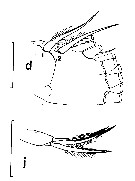 issued from : J.C. von Vaupel Klein in Crustaceana, Supplt 9, Studies on Copepoda, III, 1984. [p.69, Fig.9, d, j]. Female: d, setal armature on the posterior face of the 1st inner lobe of basipodal segment 1 of left Mx1 (2 setae, numbered 1 to 2 in a proximal to distal order to compare other species; here setae 3 and 4 absent contrary in E. rostrata with 4 setae); j, complement of terminal setae on the 2nd inner lobe of basipodal segment 1 of right Mx1 (details of right appendages in anterior view; to the posterior side 2 relatively stout setae are always present, which are combined bipectinate and spinulose; showing the presence of only the proximal, i.e. the spinulose, anterior seta). Scale bars: 0.1 mm (d); 0.2 mm (j).
|
 Issued from : W. Giesbrecht in Systematik und Faunistik der Pelagischen Copepoden des Golfes von Neapel und der angrenzenden Meeres-Abschnitte. – Fauna Flora Golf. Neapel, 1892, 19 , Atlas von 54 Tafeln. [Taf.15, Fig.26]. Female : 26, P4 (posterior view). B1 = basal segment 1 (= coxa); B2 = basal segment 2 (= basis); Ri1 = endopodal segment 1.
|
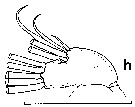 issued from : J.C. von Vaupel Klein in Crustaceana, Supplt 9, Studies on Copepoda, III, 1984. [p.65, Fig.6 h]. Euchirella bella: a, Setal armature of endopodte 2+3 of A2. Conditions are expressed are expressed in formulae as follows: number of setae in regular row on proximal lobe / relative development of seta in position no. 9 on this lobe / number of setae in approximately linear row on terminal lobe / relative development of appendicular seta no. 7 and its supporting pedestral (absent, vestigial, moderate or well developed: see Table I, p.87 and Table II, p.93). upper and lower lobes = proximal and terminal lobes (details of right appendage shown in medial aspect. Scale bar = 0.133 mm. Nota: Condition 5/0/5/1.
|
 Issued from : J.C. von Vaupel-Klein in Zool. Meded., Leiden, 19972, 47 (41). [p.503, Fig.2, a-b]. Male (from 4°03'N, 123°26'E): a, endopodite of right P1 (anterior view). Female (from same locality): b, same . Nota: 'organ of Vaupel Klein' (see explanation to Euchirella curticauda).
|
 Euchirella bella Euchirella bella female: 1 - Crest absent. 2 - Genital segment slightly asymmetrical. 3 - Genital segment with large projection on the right side (dorsal view), left side without sweeling or projection. 4 - Projection on the right of genital segment smooth, covering nearly all length of segment (dorsal view). Coxopodite of P4 with 3-4 (5) spines.
|
 issued from : Tanaka O. in Publ. Seto Mar. Biol. Lab., 1957, 6 (2). [p.187]. As Euchirella areata. Female A1: proportional lengths of segments. - A1 24-segmented, extends distal end of caudal rami by distal 2 segments. - Segments 8 and 9 separate on the posterior margin .
|
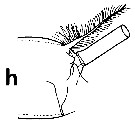 Issued from : J.C. von Vaupel Klein in Crustaceana, Supplt 9, Studies on Copepoda, III, 1984. [p.70, Fig.10, g]. Euchirella bella: Setal armature on proximo-distal corner of basis (Ba2), adjacent to the endopod (Ri) of Mx1 (left appendage in postrior view; secondary structures on large setae are not shown, and neither are the hairs on the basis proper). Only 1 small seta present, as in Euchirella amoena (Fig.10g)
|
 Issued from : J.C. von Vaupel Klein in Crustaceana, Supplt 9, Studies on Copepoda, III, 1984. [p.72, Fig.11, d]. Euchirella bella. Structure of Mx1, terminal configuration of setae plus the 'blunt tooth (= tubular pore) on the endite of basis (Ba2) (plumosity and/or spinules on setae, as well as hairs on lobe, omitted, right appendage in anterior view). Showing the usual Euchirella complement of, from anterior to posterior: short proximal seta (p), long central seta (c), blunt tooth (dotted outline) and shortest, distal seta (d). Contrary to E. curticauda with both proximal seta (p) and distal setae (d) lacking and central one strongly reduced in E. bella.
|
 Issued from : J.C. von Vaupel Klein in Crustaceana, (Supplement) 9, 1984. [p.93, Table II]. Euchirella bella Female: Datamatrix stating observed states of characters from Table I (p.87-90) presently examined; nos. refer to the input nos. used in Table I (see to the family Aetideidae).
|
 Issued from : J.C. von Vaupel Klein in Crustaceana, (Supplement) 9, 1984. [p.94, Table II (cont' d) ]. Euchirella bella Female: Datamatrix stating observed states of characters from Table I (p.87-90) presently examined; nos. refer to the input nos. used in Table I (see to the family Aetideidae).
|
 Issued from : J.C. von Vaupel Klein in Crustaceana, (Supplement) 9, 1984. [p.95, Table II (cont' d) ]. Euchirella bella Female: Datamatrix stating observed states of characters from Table I (p.87-90) presently examined; nos. refer to the input nos. used in Table I (see to the family Aetideidae).
| | | | | Ref. compl.: | | | Sewell, 1948 (p.328, 532, 534, 535, 538, 539, 540, 541, 542, 552, 566, 567); Ganapati & Shanthakumari, 1962 (p.8, 15); Mullin, 1966 (p.546, Table I, III, diet); Grice & Hulsemann, 1965 (p.223); 1967 (p.15); Timonin, 1971 (p.281, trophic group); Björnberg, 1973 (p.324, 386); Guangshan & Honglin, 1984 (p.118, tab.); Longhurst, 1985 (tab.2); Madhupratap & Haridas, 1986 (p.105, tab.1); 1990 (p.305, fig.4: vertical distribution night/day; fig.7: cluster); Heinrich, 1990 (p.17); Shih & Young, 1995 (p.67); Padmavati & Goswami, 1996 a (p.85, Table 4, vertical distribution); Suarez-Morales & Gasca, 1998 a (p107); Fernandez-Alamo & al., 2000 (p.1139, Appendix); Zuo & al., 2006 (p.162: tab.1); Jitlang & al., 2008 (p.65, Table 1); Fernandes, 2008 (p.465, Tabl.2); Ayon & al., 2008 (p.238, Table 4: Peruvian samples); McKinnon & al., 2008 (p.843: Tab.1); C.E. Morales & al., 2010 (p.158, Table 1); Tutasi & al., 2011 (p.791, Table 2, abundance distribution vs La Niña event); Sano & al., 2013 (p.11, Table 7, food habits) | | | | NZ: | 8 | | |
|
Carte de distribution de Euchirella bella par zones géographiques
|
| | | | | | | | |  Issued from : M. Madhupratap & P. Haridas in J. Plankton Res., 12 (2). [p.312, Fig.4]. Issued from : M. Madhupratap & P. Haridas in J. Plankton Res., 12 (2). [p.312, Fig.4].
Vertical distribution of calanoid copepod (mean +1 SE), abundance No/100 m3. 35- Euchirella bella.
Night: shaded, day: unshaded.
Samples collected from 6 stations located off Cochin (India), SE Arabian Sea, November 1983, with a Multiple Closing Plankton Net (mesh aperture 300 µm), in vertical hauls at 4 depth intervalls (0-200, 200-400, 400-600, 600-1000 m). |
| | | | Loc: | | | South Africa, Canary-Azores, G. of Aden, Maldive Is., Laccadive Is., South equatorial Indian Ocean, Arabian Sea, India (Goa - Gujarat, Lawson's Bay), Bay of Bengal, Australia (North West Cape), Indonesia-Malaysia, Flores Sea, Philippines, China Seas (East China Sea, South China Sea) , S Japan (Kuchinoerabu Is.), Japan (Izu), Mariana Trench, Pacif. (W equatorial), Caroline-Marshall is., G. of Tehuantepec, off W Guatemala, Pacif. (equatorial), SW Galapagos, Galapagos- Ecuador, Peru, Pacif. (SE tropical), Chile (N, Concepcion).
Type locality: 15°N, 138°W. | | | | N: | 44 | | | | Lg.: | | | (11) F: 3,86-3,68; (37) F: 4,18-3,7; M: 3,7-3,26; (41) M: 3,15; (47) F: 3,8; (56) F: 3,75; (78) F: ± 3,5; (101) F: 4,18-3,8; M: 3,36; 3,33; (110) F: 4,85-3,8; M: 3,36-3,26; (187) F: 4,12; (290) F: 3,8-3,85; (855) F: 3,68-3,86; M: 3,1-3,2; (1122) F: 3,7; M: 3,15; (1257) F: 3,5-3,75; {F: 3,50-4,85; M: 3,10-3,85}
The mean female size is 3.889 mm (n = 17; SD = 0.3073), and the mean male size is 3.287 mm (n = 10; SD = 0.1715). The size ratio (male : female) is 0.835 (n = 5; SD = 0.0432). | | | | Rem.: | épi-hadal.
Certaines localisations dans le Pacifique ne sont pas sûres.
Les auteurs ne sont pas en accord sur les synonymies.
Voir aussi les remarques en anglais | | | Dernière mise à jour : 22/02/2021 | |
|
|
 Toute utilisation de ce site pour une publication sera mentionnée avec la référence suivante : Toute utilisation de ce site pour une publication sera mentionnée avec la référence suivante :
Razouls C., Desreumaux N., Kouwenberg J. et de Bovée F., 2005-2025. - Biodiversité des Copépodes planctoniques marins (morphologie, répartition géographique et données biologiques). Sorbonne Université, CNRS. Disponible sur http://copepodes.obs-banyuls.fr [Accédé le 02 janvier 2026] © copyright 2005-2025 Sorbonne Université, CNRS
|
|
 |
 |
























